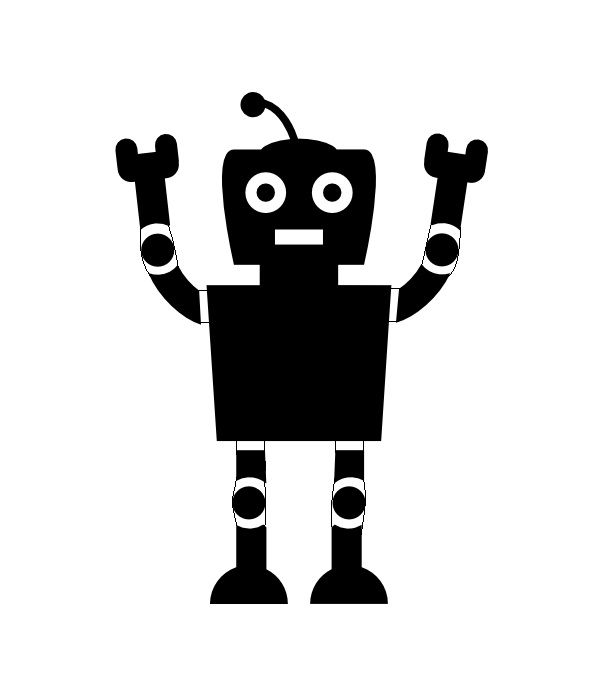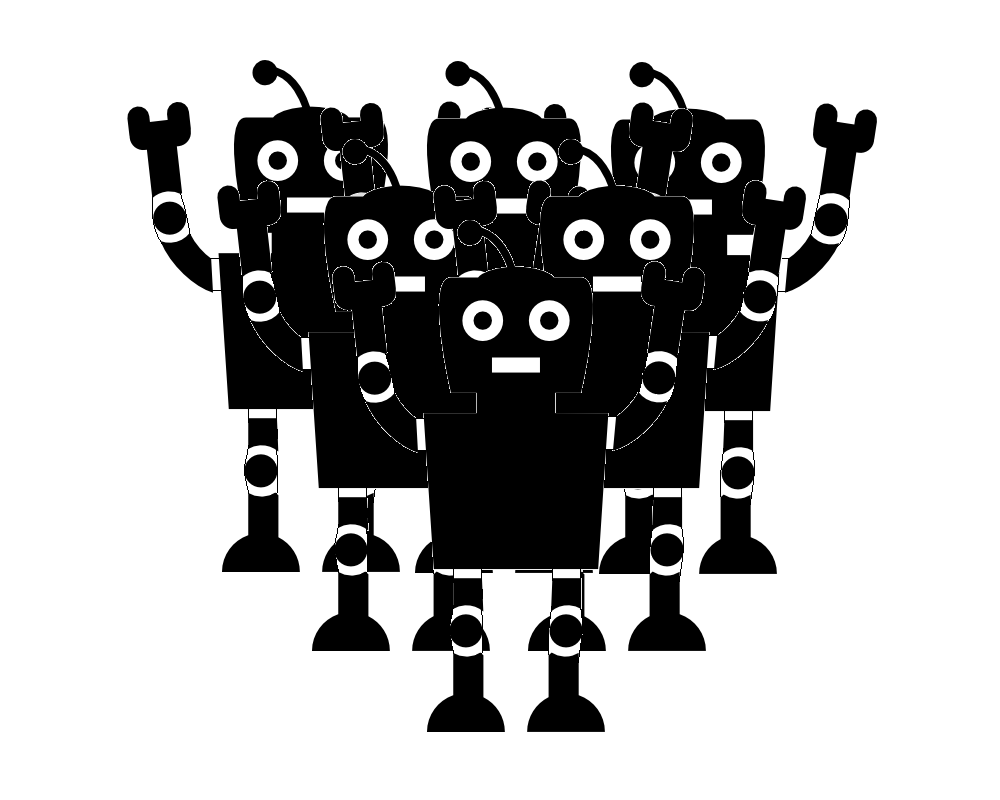Introduction
This is the project for the course Multi-Agent systems in the academic year 2016-2017 by Sjaak ten Caat, Denny Diepgrond and Stefan Knegt. We will demonstrate the possibility to model a multi-agent story with epistemic logic.
Problem Outline
For our project, we will be looking at a short story by Isaac Asimov called Little Lost Robot. In this story the main character, Susan Calvin, is tasked with finding a robot among multiple almost identical other robots. The robot she is looking for, is trying to hide actively. This robot, called NS-2, uses all of its knowledge about the other robots to make sure that it reacts in exactly the same way as they do. What is known to everyone is that every normal robot will follow the three laws of robotics, namely:
- A robot may not injure a human being or, through inaction, allow a human being to come to harm.
- A robot must obey the orders given it by human beings except where such orders would conflict with the First Law.
- A robot must protect its own existence as long as such protection does not conflict with the First or Second Laws.
Theory
In the 'Little Lost Robot' story we can identify three separate agents: Susan, the lost robot and the normal robots. The normal robots are all exact duplicates so it is irrelevant how many there are for the purpose of this analysis. Therefore we will only consider one. Let Susan be agent S, the lost robot be agent L, and the normal robot be agent N. Since the story deals with what agents believe, rather than what they know, we used the KD45 system. So we define the model to be used as $M = \langle S, \pi, R^B_S, R^B_L, R^B_N\rangle$. We define the propositional atoms as- $Gr$ = gamma radiation is present
- $Ir$ = infrared radiation is present
- $Dr$ = dangerous radiation (for robots) is present
- $Hd$ = the situation is dangerous for humans
- $La$ = the lost robot acts
- $Na$ = the normal robot acts
- $M\models C (Hd \leftrightarrow Na)$ : It's common knowledge that normal robots will act if and only if a human is in danger.
- $M\models C (B_L(Na) \rightarrow La)$ : It's common knowledge that, whenever the lost robot thinks that the normal robot will act, it will also act.
- $M\models C (B_L(\neg Na) \rightarrow \neg La)$ : It's also common knowledge that when the lost robot believes that the normal robot will not act, it will also not act.
- $M \models C((Hd \land \neg Dr) \leftrightarrow Na)$ : Normal robots will only act if someone is in danger when there is no dangerous radiation present, since they will not be able to do anything before being destroyed. This rule replaces the very first rule.
- $M \models B_L (Gr \leftrightarrow Dr)$ : The lost robot believes that gamma radiation and only gamma radiation counts as dangerous radiation.
- $M \models B_N ((Gr \lor Ir) \leftrightarrow Dr)$ : The normal robot believes that every type of radiation is dangerous radiation, since they cannot distinguish between different types.
- $M \models B_L (B_N (Gr \leftrightarrow Dr))$ : The lost robot believes that the normal robot also believes that it only needs to be aware of gamma radiation.
- $M \models B_S (B_N ((Gr \lor Ir) \leftrightarrow Dr))$ : Susan believes that normal robots cannot distinguish between infrared and gamma radiation.
- $M \models B_S (B_L (B_N (Gr \leftrightarrow Dr)))$ : Susan also believes that the lost robot believes that the normal robot believes that it is only in danger when there is gamma radiation.
Simulation
The epistemic situation in the above-mentioned story of the Little Lost Robot is simulated below. By using the switches, the user can make propositional atoms that were mentioned in the Theory section either true or false. After changing one or more switches, a new model can be generated by clicking the button on the bottom of the Simulation. In the boxes under a particular agent, the epistemic atoms that are true for the corresponding agent are shown. There also is a box with general knowledge in which the common knowledge in the model is shown. The truth valuations for all agents are based on the initial situation and the formulas given in the Theory section.
We implemented this first simulation to represent the three experiments Susan conducted to find the lost robot in the original story:
Feel free to experiment with other settings that do not correspond with Susan's experiments to see how the agents use the epistemic logic in the system. An extended simulation with additional functionalities can be found in the section below.




Extended Simulation
We have also created a separate simulation with some additions to the original simulation. We will first give a brief summary of each addition, as well as how it changes the simulation.- Allow Susan to tell each robot what they should perceive as dangerous. In the original experiment, Susan warned both robots about the dangers of gamma radiation. In this simulation, we give the user control about what Susan should tell each robot what they should watch out for. For instance, to simulate the original experiment, the user would check "gamma radiation" for both the lost robot and the normal robot. The same difference between the lost robot and the normal robot remains, so normal robots are still unable to distinguish between different types of radiation. This means that warning the normal robot about either gamma radiation or infra-red, will result in the robot seeing both as dangerous. On the other hand, selecting only infra-red for the lost robot has the consequence that it will still act if there is gamma radiation present, and the same applies if the lost robot is warned about gamma-radiation and infrared is present. This can be expressed in the formulas $M \models B_N((Gr \rightarrow Dr) \leftrightarrow (Ir \rightarrow Dr))$, which replaces $M \models B_N ((Gr \lor Ir) \leftrightarrow Dr)$ in the original situation, $M \models \neg B_L((Gr \rightarrow Dr) \leftrightarrow (Ir \rightarrow Dr))$, which replaces $M \models B_L (Gr \leftrightarrow Dr)$, and finally $M \models B_L(\neg B_N((Gr \rightarrow Dr) \leftrightarrow (Ir \rightarrow Dr)))$, which replaces $M \models B_L (B_N (Gr \leftrightarrow Dr))$. Susan is still aware of these differences, so we also replace $M \models B_S (B_N ((Gr \lor Ir) \leftrightarrow Dr))$ and $M \models B_S (B_L (B_N (Gr \leftrightarrow Dr)))$ with $M \models B_S (B_N((Gr \rightarrow Dr) \leftrightarrow (Ir \rightarrow Dr)))$ and $M \models B_S(B_L(\neg B_N((Gr \rightarrow Dr) \leftrightarrow (Ir \rightarrow Dr))))$. This changes the goal state, as it is no longer enough for one robot to act differently than the other robot, since this could be explained by the difference in what they were told beforehand, rather than one robot actually being the lost robot. Instead, Susan will now have to reason for both robots if their reactions, given what they are told, is consistent with how the lost robot would act and how a normal robot would act. Then, if a robot's response is not consistent with that of a normal robot, it must be the lost robot. Also, if a robot's response is not consistent with that of the lost robot, then the other robot must be the lost robot. We first change the axiom $Dr$ to $Dr_{(x,i)}$, which now means "The situation is dangerous according to robot i if it were agent x", with x and i being either the lost or the normal robot. Then, we can represent the goal states as the formulas $B_S((Dr_{(La,Na)} \land La) \lor (Dr_{(Na,La)} \land Na))$ as well as $B_S((\neg Dr_{(La,Na)} \land Hd \land \neg La) \lor (\neg Dr_{(Na,La)} \land Hd \land \neg Na))$. In the first case, one of the robots reveals their identities by acting when the other robot wouldn't have, while in the second case it does so by not acting when the other would have.
- Allow more normal robots to be created Without the first addition, this feature would change nothing since each normal robot would act the same way. However, if Susan were to tell each robot something different, then they will act different as well. This changes when Susan can identify the lost robot. Where before it would have been enough if one normal robot acted in a way that it could not be the lost robot, this is no longer true if there are two or more normal robots, since there would still be two or more robots that could potentially be the lost robot. Instead, every normal robot should act in a way that the lost robot would not, so that the lost robot can be identified by process of elimination. However, it is still enough if the lost robot acts unlike how a normal robot would act.
- Allow different scenarios We've added two extra scenarios, which both change the difference between what the lost robot believes and what the normal robots believe. The user can select the desired scenario using a drop-down menu. The first option is the original problem, in which the lost robot can distinguish between infra-red and gamma radiation, while the normal robots cannot. When choosing the second option, the lost robot will infer that, should gamma radiation be present, then electricity is present as well, while also assuming that the other robots believe this as well, and Susan is again aware of this difference. So we add the rules $M \models B_L(Gr \rightarrow El)$, $M \models B_L(B_N(Gr \rightarrow El))$, $M \models B_S(B_L(B_N(Gr \rightarrow El)))$ and $M \models B_S(\neg B_N(Gr \rightarrow El))$, where $El$ stands for "electricity is present". These replace the rules $M \models B_N((Gr \rightarrow Dr) \leftrightarrow (Ir \rightarrow Dr))$, $M \models \neg B_L((Gr \rightarrow Dr) \leftrightarrow (Ir \rightarrow Dr))$, $M \models B_L(\neg B_N((Gr \rightarrow Dr) \leftrightarrow (Ir \rightarrow Dr)))$, $M \models B_S (B_N((Gr \rightarrow Dr) \leftrightarrow (Ir \rightarrow Dr)))$ and $M \models B_S(B_L(\neg B_N((Gr \rightarrow Dr) \leftrightarrow (Ir \rightarrow Dr))))$ . In the third scenario, only the lost robot believes it should always act when a human is in danger, regardless of the dangers present. So this scenario replaces the rule $M \models C((Hd \land \neg Dr) \leftrightarrow Na)$ with $M \models B_N((Hd \land \neg Dr) \leftrightarrow Na)$, $M \models B_L(Hd \leftrightarrow Na)$, $M \models B_S(B_N((Hd \land \neg Dr) \leftrightarrow Na))$ and $M \models B_S(B_N(Hd \leftrightarrow Na))$.
1. Which circumstances should Susan warn the robots about?
3. What will be present in the experiment?
4. How each agent will react given what they are told, the scenario and what they perceive during the experiment.




Epistemic Analysis
We model theory of mind-properties for the agents with the KD45 system and added beliefs. The idea of bridging cognitive science and logic, by using dynamic epistemic logic to model theory of mind is not new (Verbrugge, 2009). Pol et al. (2016) used dynamic belief updates in a computational-level model of theory of mind. This way they formalize the aspect of theory of mind regarding the attribution of mental states. In the model they focus on epistemic states, in particular on belief. Our model is based on their approach. The most important difference is that in our model, the belief updates will not be based on sequences of actions but on public announcements that change the beliefs of the agents.
Kripke Model
In the figures below, Kripke models can be created that display the epistemic situation corresponding to the state of the system after certain public announcements. To start or reset the creation of Kripke models, press the "Generate new Kripke model" button.
Conclusion
We have shown that it is possible to model a multi-agent story like "the Little Lost Robot" by Isaac Asimov with epistemic logic based on belief updates. This project was not only intended to demonstrate the possibility of modeling theory of mind-stories using dynamic epistemic logic. By guiding the user through the system using simulations, the functioning of the epistemic logic framework can be made clear for people with basic knowledge of modal logic.